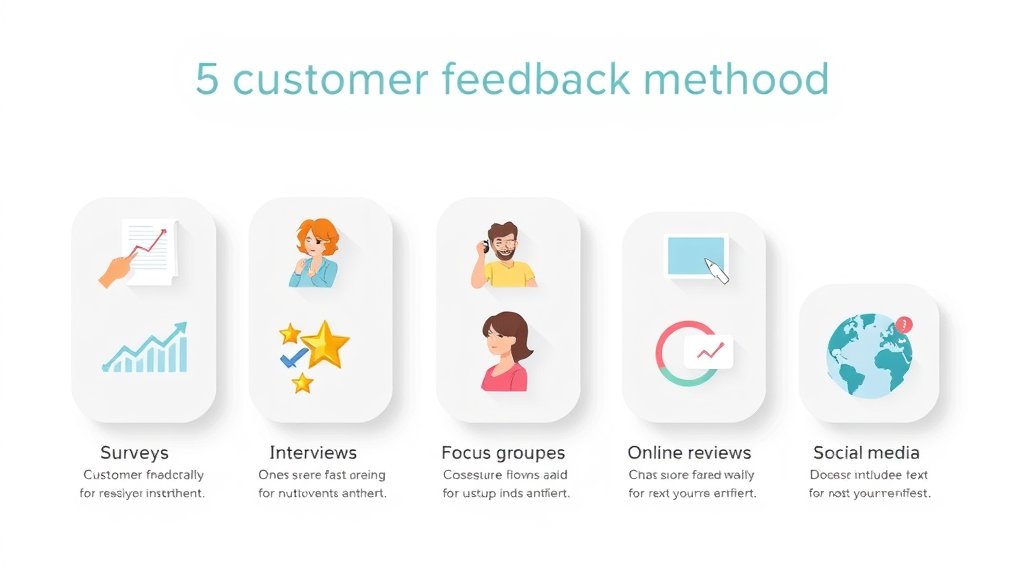Did you know that over half of consumers worldwide—52%—believe companies must act on their feedback? In today's competitive landscape, having a robust customer feedback strategy isn’t just nice-to-have—it’s the cornerstone of lasting success. The way you collect, analyze, and respond to customer feedback can either catapult your brand ahead or leave it lagging behind. Ready to unlock how effective feedback strategies can fuel loyalty, drive growth, and turn every comment into a business breakthrough? Dive in to discover the secrets industry leaders use to transform listening into real results.
The Impact of an Effective Customer Feedback Strategy: Why It’s a Game Changer
Implementing a comprehensive customer feedback strategy directly influences every aspect of your business—from enhancing customer satisfaction and loyalty to fueling product innovation and growth. When organizations make customer feedback a priority, they don’t just gather opinions—they gain actionable insights that clarify pain points, improve the customer experience, and secure a competitive advantage. Consider global brands like Amazon or Starbucks; they consistently use feedback to refine experiences, leading to customer loyalty and elevated satisfaction rates.
Effective strategies go beyond collecting isolated responses. They facilitate ongoing dialogue, inviting customers to share insights across channels—be it feedback surveys, social media, or direct conversations with customer service teams. This holistic approach helps uncover emerging trends, identify blind spots within the customer journey, and inform business decisions at every level. In a world where reviews are public and word-of-mouth spreads fast, the ability to rapidly act on feedback drives both reputation and trust.

"Did you know 52% of people around the globe believe that companies need to take action on feedback provided by their customers?" – Trustpilot Global Survey
- Elevates customer satisfaction by consistently addressing pain points
- Boosts customer loyalty with visible, meaningful action on feedback
- Drives business growth through continuous service and product innovation
- Constructs a robust feedback loop that keeps customers engaged
How a customer feedback strategy boosts customer loyalty and retention
Customers feel valued when their voices lead to visible change. A strong customer feedback strategy demonstrates that your business cares, resulting in higher customer loyalty and retention. This connection lowers churn rates, enhances customer life cycles, and inspires brand advocacy. When you invite feedback and show it matters—whether through rewards, follow-ups, or service improvements—you build a community of loyal customers invested in your business’s success.
On the contrary, neglecting feedback can quickly erode trust. Imagine receiving negative feedback with no acknowledgment or improvement. Customers may feel ignored, leading to poor reviews and lost business. By prioritizing two-way communication and demonstrating action, you transform casual buyers into long-term brand champions.
Unlocking real improvements in customer service and experience with a feedback strategy
Customer feedback is more than data—it’s the blueprint for better customer service and memorable experiences. By utilizing feedback tools such as feedback surveys and real-time dashboards, companies pinpoint friction in the service process, correct inefficiencies, and empower teams with relevant training. This continuous improvement cycle not only boosts metrics like satisfaction and Net Promoter Scores but also sparks innovations that set your brand apart.
For example, hospitality brands might overhaul check-in processes or add digital conveniences based on guest suggestions, improving both satisfaction and operational efficiency. The result? Customers notice improvements, spread positive word-of-mouth, and increase their loyalty over time.
What You’ll Gain from Perfecting Your Customer Feedback Strategy
When you master your customer feedback strategy , you unlock benefits that extend far beyond immediate problem-solving. You generate a treasure trove of actionable insights that drive everything from product development to customer service initiatives. By proactively addressing pain points, you ensure customers feel heard and valued, which directly enhances your brand’s reputation and market position.
- Increased customer satisfaction and loyalty —proactive action based on feedback keeps customers happy and loyal
- Actionable insights —clear direction for product and service improvements
- Effective response to negative feedback —turn potential critics into advocates by addressing their concerns with care
- Enhanced brand reputation and trust —consistent follow-through strengthens public perception and trust

Defining an Effective Customer Feedback Strategy: Frameworks and Fundamentals
A winning customer feedback strategy is built on deliberate frameworks that ensure feedback isn’t just collected, but meaningfully analyzed and acted upon. These frameworks guide organizations through systematic collection, robust measurement, actionable analysis, and—most crucially—delivering genuine change based on what’s heard.
Without a structured approach, it’s easy to be overwhelmed by volumes of input. Leading companies implement clear processes and assign teams responsible for each stage—from designing survey questions to reviewing outcomes and closing the feedback loop. This foundational structure prepares you to scale your strategy as your customer base and touchpoints grow.
Key components and feedback strategy frameworks
Every successful feedback strategy starts with four key pillars: feedback collection , measurement, analysis, and action. In the collection phase, businesses use tools ranging from feedback surveys to interviews. Measurement requires selecting the right feedback metrics such as Net Promoter Score (NPS) or Customer Satisfaction Score (CSAT). Robust analysis reveals priority pain points and emerging trends, while the action phase closes the loop—demonstrating tangible changes based on insights gathered. Frameworks like the feedback loop ensure your strategy remains cyclical and evolving, rather than static.
- Feedback collection: Gathering insights through surveys, focus groups, interviews, and digital platforms
- Measurement: Quantifying customer sentiment with metrics like NPS, CSAT, and CES
- Analysis: Uncovering root causes, pain points, and actionable opportunities
- Action: Implementing changes and consistently communicating back to customers
Customer feedback loop: Building continuous improvement into your feedback strategy
The heart of every advanced customer feedback strategy is the feedback loop. This loop ensures ongoing learning—collect, analyze, act, and communicate, then repeat. By embedding this cycle, your organization transforms one-time responses into a continuous stream of improvement opportunities. Transparent communication throughout the loop assures customers their input leads to visible progress, increasing engagement and fostering trust. Companies who master the customer feedback loop continuously refine their customer experience and drive lasting growth.
| Framework | Pros | Cons |
|---|---|---|
| Closed Feedback Loop | Ensures every response is addressed Drives high customer loyalty | Resource-intensive Requires strong communication processes |
| Real-Time Monitoring | Immediate insights Quick resolution of pain points | Can be overwhelming May miss long-term trends |
| Periodic Deep-Dive Analysis | Identifies macro-trends Guides strategic initiatives | Slower to respond May overlook urgent issues |
Top 5 Methods for Collecting Customer Feedback: Which One Is Best for Your Strategy?
Choosing the right tools for collecting customer feedback is crucial for an actionable feedback strategy. Matching the method to your customer base and objectives is key. Combining several methods—such as feedback surveys, focus groups, and social media monitoring—ensures well-rounded insights and maximizes response rates. Adapt your mix based on customer demographics and the nature of your product or service to reach and engage as wide an audience as possible.

Feedback surveys and customer feedback surveys: Essential tools for listening at scale
Feedback surveys are the workhorse of any customer feedback strategy. From quick online polls to detailed customer feedback surveys, these tools efficiently gather broad or deep insights at scale. To maximize value, design survey questions that are simple, specific, and directly tied to business goals. Leverage both quantitative metrics (like ratings or Net Promoter Score) and qualitative responses for richer customer insights. Regular surveys—with clear incentives and follow-up—boost response rates and provide the data needed for continuous improvement.
Additionally, segmented feedback surveys can reveal what specific customer groups think, offering even more targeted areas for product or service improvement. Whether following up after a purchase, support interaction, or event, surveys make feedback collection systematic and actionable.
Leveraging social media for instant customer feedback
Social media platforms present a gold mine for instant, candid feedback. Monitoring mentions, shares, public comments, and direct messages can reveal pain points and praise in real-time. With a well-developed feedback strategy, you can quickly spot trends, respond to emerging issues, and demonstrate transparency—all vital for brand credibility. Integrate social media listening tools with your overall feedback loop to ensure no insight falls through the cracks.
Brands effectively using social listening keep their finger on the pulse of public sentiment. They can address negative feedback quickly and use positive comments as testimonials, thereby strengthening the trust between the company and its customers in a highly visible way.

Using focus groups and interviews to deepen your customer feedback strategy
While surveys are scalable, focus groups and one-on-one interviews provide nuanced, qualitative feedback that uncovers the “why” behind customer opinions. By engaging directly with smaller customer segments, you identify pain points and gain in-depth insights into their experiences with your product or service. This method is especially useful when launching new products, addressing persistent issues, or refining the customer journey. Structure your focus group sessions with open-ended questions and use recordings and notes to analyze responses for recurring themes.
Interviewing individual customers—particularly those with strong opinions, whether positive or negative—can reveal hidden frustrations and inform improvements that fundamentally shape your customer experience.
Feedback tools and customer feedback tools for real-time responses
Modern feedback tools such as live chat pop-ups, website widgets, and mobile app integrations allow businesses to collect and act on customer insights instantly. These customer feedback tools not only increase response rates but also support immediate intervention—often resolving concerns before they escalate into public complaints. Many tools offer integrations with analytics platforms, helping turn raw feedback into actionable data within your feedback strategy framework.

Engaging customer service teams as feedback collectors
Your front-line customer service teams are invaluable partners in collecting customer feedback . Train staff to ask for opinions during interactions, document common pain points, and communicate regularly with decision-makers. Empowered teams who understand the feedback loop and respond with empathy drive loyalty and ensure every customer feels heard. When integrated into your overall strategy, feedback from service teams balances quantitative data from surveys and digital tools, offering a complete perspective on the customer journey.
"The best feedback is candid, unsolicited, and ongoing."
Designing Your Feedback Loop: Closing the Loop with Customers
Closing the feedback loop is about turning insights into clear, meaningful action. A well-designed loop ensures you collect feedback, respond effectively, and communicate resulting changes to your customers. This not only solves immediate pain points but also reinforces trust—showing your business values every opinion and strives for greater customer satisfaction. A feedback strategy that delivers on this promise keeps customers engaged, loyal, and more likely to share future feedback.

How a well-configured feedback loop elevates your customer feedback strategy
When each feedback cycle ends with tangible updates or responses, customers recognize the value of participating. A closed feedback loop builds a virtuous cycle: more customers contribute, your organization learns and improves, and customer loyalty surges. Successful brands embed these loops into all channels—digital platforms, in-person service, and social media—ensuring every comment is acknowledged. Integrating automated responses with personalized follow-ups can make this process more efficient while keeping it human and authentic.
Techniques for collecting feedback and responding effectively
To gather valuable input, frame survey questions to be clear, specific, and relevant to the customer’s context. Actively solicit feedback at ideal touchpoints, such as immediately after product delivery or customer service resolutions. Use templates and training so your team responds promptly, acknowledges customer concerns, and explains the steps your business will take. Transparency and speed are crucial—customers want to know their feedback is both received and respected.
Turning negative feedback into opportunities for service recovery
No business is immune to negative feedback . Rather than shying away, successful companies treat criticism as a roadmap for improving both customer service and the overall experience. Respond to detractors with empathy, apologize where necessary, and communicate the changes you will enact. Involving your product team or service leaders in reviewing negative comments often sparks innovation and can transform critics into loyal promoters. Each piece of negative feedback represents a unique opportunity to demonstrate your company’s commitment to exceptional service and problem resolution.
- Respond swiftly to feedback, positive or negative
- Close the loop with a summary of actions taken
- Formalize processes for moving from collection to resolution
- Follow up after changes to measure ongoing satisfaction
Analyzing Customer Feedback: Tools, Metrics, and Tactics
Without the right tools and metrics, even the most enthusiastic feedback gathering can end in data overwhelm. Smart customer feedback analysis brings clarity: transforming input into measurable insights that inform your next business moves. Best-in-class businesses use a range of customer feedback tools to collect, categorize, and analyze qualitative as well as quantitative data, spotlighting trends and opportunities for improvement in real time.

Top customer feedback tools to collect, sort, and analyze insights
Leading feedback tools include survey platforms (like SurveyMonkey or Google Forms), social listening dashboards (such as Hootsuite or Sprout Social), review management suites (Yotpo, Trustpilot), and comprehensive customer feedback platforms (Qualtrics, Medallia). Choose solutions that support your collection channels, offer rich analytics, and streamline follow-up. Integration between tools is key—ensuring insights are actionable and accessible across product, marketing, and customer success teams.
Key metrics to monitor in your customer feedback strategy
Successful teams monitor both quantitative and qualitative feedback to assess and refine their strategy. Key customer feedback metrics include:
- NPS (Net Promoter Score): Measures likelihood of customers recommending your brand
- CSAT (Customer Satisfaction Score): Tracks how well you meet or surpass expectations
- CES (Customer Effort Score): Evaluates how easy it is for customers to get their needs met
- Qualitative feedback: Open-ended responses revealing context, motivations, and ideas
| Metric | What It Measures | Best Use |
|---|---|---|
| NPS | Likelihood to recommend (loyalty indicator) | Overall brand health; identify promoters and detractors |
| CSAT | Immediate satisfaction with a product/service | Evaluate transactions or specific interactions |
| CES | Ease of resolving an issue or completing a process | Assess support touchpoints; spot process bottlenecks |
| Qualitative Feedback | Context, suggestions, and detailed pain points | Understand the “why” behind scores; fuel innovation |
From Data to Action: Transforming Customer Feedback Into Business Results
The power of your customer feedback strategy is measured by the impact it has on your business, not just by the volume of data you collect. Closing the loop means integrating feedback insights into your product team’s roadmaps, refining service processes, and guiding company-wide priorities. Strategic use of feedback not only resolves individual complaints but fuels organization-wide innovation and competitive differentiation.
Integrating customer feedback strategy insights with product and service improvements
Turn feedback into action by routing key insights to your product or service owners. For example, repeated comments about a confusing feature inform UI/UX enhancements; suggestions for new services shape your next offering. Host regular feedback review sessions—where cross-functional teams analyze survey results, social media reviews, and customer pain points—to ensure insights lead to concrete improvements.
Empowering teams with customer feedback: Customer service and experience alignment
Create a culture where every department—especially customer service—uses feedback to anticipate needs, preempt issues, and deliver “wow” moments. This alignment improves both transactional and relational aspects of the customer experience and ensures consistent messaging from marketing through support and beyond. Continual training, feedback-sharing meetings, and recognition of service teams who act on insights help solidify this connection.
Feedback-driven innovation: Encouraging continuous product development
Use feedback as a catalyst for ongoing innovation. The best brands treat feedback not as a one-time event but as the source of iterative product and process enhancement. Encourage teams to pilot new ideas, launch improvements, and rapidly test and measure results. Share wins with your customer base, inviting further suggestions to keep the innovation cycle spinning.

- Assign ownership of specific feedback insights to relevant teams
- Prioritize initiatives based on impact and frequency of feedback
- Track progress and communicate updates to customers
- Embed learnings into ongoing business planning
Building Customer Loyalty: The Long-Term Value of a Strong Customer Feedback Strategy
Consistently acting on customer feedback breeds trust—and with it, unmatched customer loyalty . Reward customers who participate in your feedback strategy with public recognition, exclusive offers, or loyalty program points. Beyond tangible rewards, the most powerful incentive is clear communication that real change is happening thanks to customer input. Over time, this cements an emotional bond that turns satisfied customers into repeat buyers and enthusiastic brand ambassadors.
Strategies for fostering loyalty through feedback-driven service
Operationalize your feedback strategy to show customers they are true partners in your brand’s journey. Share case studies of changes sparked by feedback, feature customer quotes in marketing, and create co-creation opportunities. Recognize top contributors with VIP perks and involve them in testing new features or offerings. The result is a powerful feedback loop that delights and retains your most valuable customers.

- Offer discounts, free products, or loyalty points for regular feedback
- Publicly recognize customers who provide valuable insights
- Invite feedback contributors to participate in beta tests or focus groups
- Keep contributors informed about how their feedback influenced improvements
The Role of Social Media in Modern Customer Feedback Strategy
Social media is a real-time arena for both spontaneous and targeted customer feedback. Integrating social listening into your overall feedback strategy helps you respond rapidly, spot viral trends, and build public trust. Equip your team with monitoring tools and clear guidelines for engaging with both praise and criticism online, ensuring your brand remains approachable and trustworthy on every platform.
How to integrate social listening into your overall feedback strategy
Set up social media monitoring dashboards to capture mentions, tags, reviews, and direct messages across all major channels. Use the insights gleaned to complement survey and interview data, revealing deeper patterns and sentiment shifts. Assign responsibility for timely responses, and leverage social listening to identify influencers and advocates who can help amplify positive feedback.
- Monitor channels daily for new feedback and emerging issues
- Use automation for first-line responses, then follow up with personal engagement
- Publicly thank customers for feedback and update the community on changes
- Leverage feedback trends for marketing and feature development
People Also Ask: What are 5 methods of obtaining feedback from customers?
Exploring multiple approaches including feedback surveys, interviews, focus groups, online reviews, and social media monitoring
There are five main methods for obtaining rich and diverse feedback from your customers: 1) feedback surveys for scale and efficiency; 2) one-on-one interviews that reveal deep insights; 3) focus groups that uncover group sentiment; 4) online reviews for candid, public input; and 5) social media monitoring for real-time feedback and engagement. Each method serves a unique role within a modern feedback strategy, giving you the power to respond to pain points, track response rates, and strengthen your company’s reputation through proactive interaction.

People Also Ask: What is a feedback strategy?
Definition and objectives of an ideal customer feedback strategy in business
A feedback strategy is a structured system for collecting, analyzing, and responding to customer insights . The primary objectives are to improve products and services, increase customer satisfaction, close the feedback loop, and inform business growth with data-driven decisions. An ideal customer feedback strategy aligns with business goals and ensures every piece of feedback—positive or negative—translates into actionable improvements.
People Also Ask: What is the framework for customer feedback?
Core stages: feedback collection, analysis, implementation, and review
An effective framework follows a clear process: first, collect feedback through various channels. Next, analyze input for key trends and pain points, using both quantitative and qualitative methods. Then, implement changes and improvements based on the analysis. Finally, review outcomes regularly, using metrics like Net Promoter Score and customer satisfaction to measure the effectiveness of your actions, and communicate results to customers for continuous trust and engagement.
People Also Ask: What is an example of good customer feedback?
Examples of useful and actionable customer feedback in various industries
Good feedback is specific, constructive, and actionable: “I had trouble finding the checkout button on your website. Placing it near the cart icon would make it easier to complete my purchase.” In the hospitality industry, a guest may note, “Staff greeted me by name, which made me feel valued. More vegan menu choices would improve my next stay.” Actionable feedback gives clear direction for change—helpful for teams focused on customer satisfaction or improved customer service .
Real-World Success: Brands Winning with Customer Feedback Strategies

Case study: A leading brand’s customer feedback loop in action
Consider a leading online retailer that noticed declining repeat purchases. By launching well-timed feedback surveys and incentivizing responses, they discovered pain points tied to delivery speed and confusing product descriptions. After optimizing logistics and rewriting copy, the company not only raised their NPS by 18 points but also saw a 15% increase in customer loyalty . Clear communication—email updates and a public thank-you campaign—closed the loop, encouraging further engagement and strengthening brand reputation.
- Incentivize feedback to capture authentic responses
- Analyze input quickly; involve cross-functional teams for fast implementation
- Regularly update customers on how their feedback drives change
- Celebrate improvements to build community and sustain momentum
Common Challenges and Solutions in Customer Feedback Strategy
Overcoming barriers to collecting authentic feedback
Common challenges include low response rates, survey fatigue, and fear of bias—especially with incentivized feedback. Overcome these by keeping feedback requests succinct, varying survey timing and channels, and ensuring a mix of qualitative and quantitative input. Offer incentives carefully and be transparent about how feedback is used. Most importantly, communicate openly with your audience so they know their input leads to real change.
Ensuring actionable insights rather than data overload
To avoid being buried in data, deploy analytics tools that categorize feedback by sentiment, source, and frequency. Set up clear processes for escalating critical feedback to relevant teams and automate reporting on core metrics. Focus on trending themes and high-frequency pain points to guide your service and product improvements, ensuring every insight leads to clear action rather than getting lost in spreadsheets.
- Low response rates—addressed by incentives and concise surveys
- Survey fatigue—solved by limiting requests and optimizing timing
- Data overload—overcome by actionable categorization and prioritization frameworks
- Biased feedback—reduced by mixing methods and channels for collection
Frequently Asked Questions for Your Customer Feedback Strategy
- How often should I collect customer feedback? Regularly gather feedback at key customer touchpoints—post-purchase, after support interactions, or following events. Quarterly or bi-annual deep dives help track long-term trends, but ongoing pulse surveys and social monitoring catch issues early.
- Which customer feedback tool is best for my business? The best tool matches your goals and channels—for example, use a robust survey platform for in-depth analysis and a social listening tool to capture real-time sentiment. Integration and ease of reporting should guide your final selection.
- How do I motivate customers to participate in my feedback strategy? Incentivize participation with discounts, loyalty points, or early access to new features. Always communicate the impact of their feedback by sharing changes and thanking contributors publicly or through direct follow-up.
- How should I respond to negative feedback? Respond quickly and empathetically, acknowledge the issue, explain next steps, and make clear how the feedback drives improvement. Asking for further input and following up after resolution can turn critics into loyal customers.
Key Takeaways to Master Your Customer Feedback Strategy
- Regularly gather and act on customer feedback
- Use the right tools to analyze and respond rapidly
- Make feedback a central pillar of your overall customer experience
- Leverage insights to build and sustain customer loyalty and trust
Start Building Your Own Customer Feedback Strategy Today
"A well-executed customer feedback strategy is the foundation of lasting customer relationships."
- Define clear feedback collection goals relevant to your business priorities
- Choose and implement feedback tools that match your channels and customer profiles
- Train front-line staff on soliciting, recording, and escalating feedback
- Analyze feedback weekly and share reports cross-functionally
- Assign responsible owners for acting on key insights
- Close the feedback loop with clear communication to customers
- Measure outcomes with regular reviews of NPS, CSAT, and qualitative themes
- Celebrate wins and reward customers who offer impactful feedback
Want more 5-star reviews and a strategy to manage them like a pro? Grab our Free Online Review Strategy Checklist and start building unstoppable trust online.
 Add Row
Add Row  Add
Add 




Write A Comment